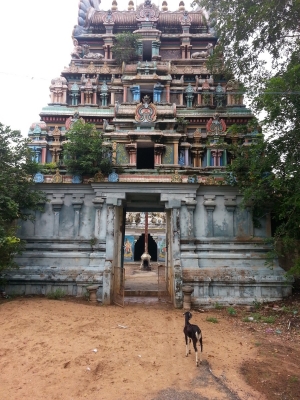Iraavatham
is the elephant-vehicle of Lord Indra at the heavens. It is with white
skin and four tusks. Once Sage Dhurvasa brought a lotus flower that
adorned the Sivalingam consecrated by the Sage at Kasi. He presented
that flower to Lord Indra who was coming in his ceremonial procession.
The arrogant Indra received the flower with one hand without any
reverence and placed it on the head of the elephant. The elephant
removed the flower with its trunk, threw it on the floor and stamped the
flower with its leg. The angry Dhurvasa cursed both Lord Indra and the
elephant. Accordingly, Iraavatham became a wild elephant and for one
hundred years went to several holy places, worshipped the deities and
finally got its original form at Madurai.
This is the legend narrated in
the Tiruvilayaadal Puranam. Tirukkottaaru is one of the holy places
worshipped by Iraavatham as a wild elephant. Subha Maharishi paid his
obeisances to this Lord every day. One day the temple doors were closed
because he was late. Seeing this Subha Maharishi took the form of a bee,
went into the sanctum and worshipped the Lord.
From then on he remained
there. From that time onwards, the beehive remains in the sanctum of
the Prime Deity. The devotees who go there to worship should stand away
from the hive and offer their prayers. It is said that honey is
extracted annually from this hive and is adorned the Lord with that
honey. The hive once again thrives.
The image of this Subha Maharishi is
seen in the rear side of the outer round. Adjacent to the front
Mantapam is the sanctum of Kumaara Bhuvaneswarar. The big Lingam faces
west. It is believed that both Sage Agathiyar and Subha Maharishi
established this imposing Lingam and worshipped.
Temple Timings:
The temple is open in the morning from 7.00 till 11.30 and from 6?o clock to 8.30 in the evening.
Temple Festivals:
Aarudhra Darisanam and Vaikaasi Visaakam were celebrated grandly in this temple.
Here
Lord Siva reveals and blesses as Swayambu Murthi. The tradition is
that Iraavatham (the Elephant) with its ivory tusk worshipped the clouds
in the sky , brought Ganges and performed pooja.
This is the 53rd holy place at the
southern banks of Kaveri, celebrated by Thevar.K?tu ? bank. This place is called ?K?ttaaru? as it is in the banks of Vaaňciyaaru.
This is ?K?ttaaru? because Iraavatham, the white elephant worshipped
the deity, after hitting the clouds and making the waters pour down like
a river.
Here the renowned sages like Agathiyar, Subha Munivar, and
Kumaarabhuvana thevar worshipped the Lord and received His benedictions.
In the inside paved corridor are the sanctum of Baala Vinaayaka,
Kailaasanaathar, Camaiyaachariaar, Subha Munivar with matted
lock of hair, Lord Muruga, Dakshinaamurti, Arthanaareeswarar,
Cantéswarar, Bhairavar, Sooriya-Chandrar, and Lord Nataraja.
Adjacent to
the front Mantapam is the sanctum of Kumaara Bhuvaneswarar. The big
Lingam faces west. In the ardha Mantapam is the old beehive formed by
the bees for very many years. We can hear the buzz of the bees in the
main sanctum. The Thevaram of Jnanacampantar is seen inscribed in the
stone.
Do's:
- Do pray Your Ishta Devata before Pilgrimage to temple
- Do Contact Temple Devasthanam information center for inquiry ,temple information and for pooja details etc.
- Do reserve your travel and accommodation at temple well in advance.
- Do bath and wear clean clothes before you enter the temple
- Do concentrate on God and Goddess inside the temple.
- Do maintain silence and recite your Istamantram to yourself inside the temple.
- Do observe ancient custom and traditions while in Temple.
- Do deposit your offerings in the hundi only
Don't s:
- Do not come to Temple for any Purpose other than worshiping of God and Goddess
- Do not smoke at Temple.
- Do not consume alcoholic drinks at Temple
- Do not Eat Non Vegetarian food in the Kshetram
- Do not approach mediators for quick Dharshanam. It may cause inconvenient to others
- Do not carry any weapon inside the temple
- Do not wear any head guards like helmets ,caps ,turbans and hats inside the temple premises
